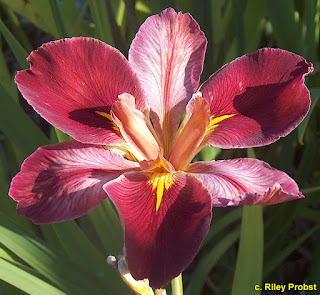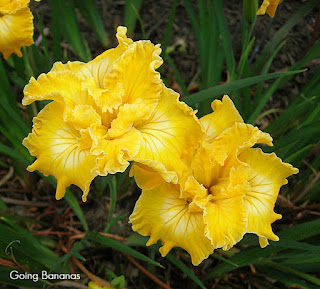by Gary Salathe
The Louisiana iris Conservation Initiative (LICI), of which I am a member of the board of directors and a volunteer, managed to get 6,000 wild Iris giganticaerulea (a species of Louisiana iris) planted in refuges and nature preserves last year. The hard work paid off, as shown in my last World of Irises Blog posting. We're targeting getting at least 6,000 irises "rescued" and planted again for 2022.
The first step in accomplishing this goal is to locate irises that are threatened with destruction and dig them up. That process has already begun with our completing three "rescues" so far this year that has brought in about 4,000 I. giganticaerulea irises to our iris holding area.
 |
Some of the irises from early spring are almost ready to move out to our projects, as shown in this photo taken on August 5th. |
 |
The same Iowa State University volunteers at the LICI iris holding area planting the irises they rescued the day before. |
Our friends from the local non-profit Common Ground Relief were hosting the Iowa State University volunteers for a week of service activities in Southeast Louisiana doing marsh restoration projects.
In June volunteers from the Students Shoulder to Shoulder organization worked with us to complete our second and third iris rescue of the season. The volunteers were high school students from around the country. They were in south Louisiana for a week of volunteering in coastal restoration projects through events held by their local host Common Ground Relief.
 |
Both of the June 2022 iris rescue events were held while the area was experiencing a heat wave with temperatures in the mid-90's. |
 |
Josh Benitez (left), co-director of Common Ground Relief, is seen digging irises with two volunteers from the Students Shoulder to Shoulder organization during one of the June iris rescue events. |
Because of the very wet weather our area has been experiencing, we likely will not be able to get out to do any more iris rescues until the middle of September. One more event should get all of the containers full at the LICI iris holding area.
We are going to be doing some maintenance at the iris holding area over the next two weeks and will also be coming up with a plan for where the irises will be planted this fall and winter. New sites have contacted us about having our irises planted there and we'd like to plant more irises at many of our ongoing projects. We're hopeful the weather will cooperate during November to allow us to get some iris rescue projects done where we can dig one day and plant the irises in projects the next day.
We will also be working over the next few weeks on getting donations to fill out our budget for the year. We welcome any size donation to help with the overhead expenses that we incur with maintaining our iris holding area and putting on volunteer events.
We are an all-volunteer-run Louisiana-registered non-profit that aims to have a big impact at a small cost. Clicking the button on our homepage will allow you to make a donation to us even if you do not have a PayPal account. A credit card will work. Any help that you can give will be greatly appreciated. Thank you so much!
The Louisiana Iris Conservation Initiative website can be found here: https://www.licisaveirises.com/
Recent articles about our work can be found here: https://www.licisaveirises.com/news
Our Facebook page can be found here: https://www.facebook.com/licisaveirises
Our email address is: licisaveirises@gmail.com

.JPG)























